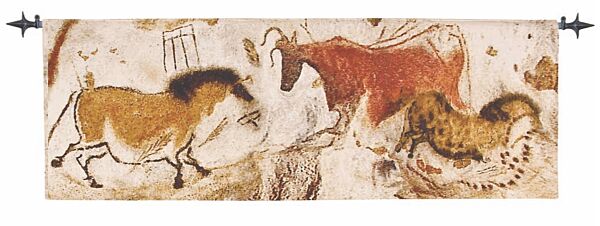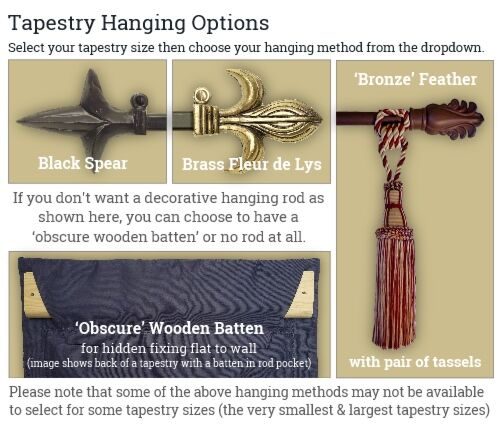Lascaux Cave Art Tapestry
This beautiful tapestry is woven on a jacquard loom by skilled weavers, keeping alive the centuries old tradition of tapestry manufacturing from generation to generation. This tapestry is fully lined incorporating a rod pocket on the back for hanging with an exclusive Heirloom flush-to-wall hanging rod. Alternatively, this tapestry can be hung with a decorative pole of your choice.
This beautiful tapestry is woven on a jacquard loom by skilled weavers, keeping alive the centuries old tradition of tapestry manufacturing from generation to generation. This tapestry is fully lined incorporating a rod pocket on the back for hanging with an exclusive Heirloom flush-to-wall hanging rod. Alternatively, this tapestry can be hung with a decorative pole of your choice.
| Tapestry Type | Loom Woven |
| Loom Woven In | Belgium |
| Height (inches) | 21 |
| Width (inches) | 62 |
Shipping
FREE SHIPPING IN THE USA by UPS (for orders over $150) $15 shipping on orders below $150. Orders will usually arrive between 14-28 working days from order date but can be delivered quicker in some circumstances.
Free Returns
If for some reason, you want to return your tapestry within our 30 day guarantee period, we will pay for the return if you want to try another tapestry of the same or greater value. If you decide you want to return the tapestry for a product refund, then you are responsible for the return shipping costs. Please note: Packaging materials need to be kept for inspection if a replacement item or refund is requested. If you do not keep the packing materials, unfortunately we cannot replace or refund your order.
Stock
1,000s of tapestries & pillows in stock in our European warehouse ready for shipping across USA & Worldwide. Although we normally hold everything in stock for quick delivery, sometimes items that are shown online for purchase aren't in stock ready for quick despatch.
Checking a Tapestry is in stock
If you are ordering for a specific event or special occasion or simply need it to arrive by a particular date please email us on [email protected] or call us on 1-800-699-6836 quoting the SKU reference and the date you need delivery by. We will quickly let you know if your desired item(s) is available within the timeframe given.
Write Your Own Review


This beautiful tapestry is woven on a jacquard loom by skilled weavers, keeping alive the centuries old tradition of tapestry manufacturing from generation to generation. This tapestry is fully lined incorporating a rod pocket on the back for hanging with an exclusive Heirloom flush-to-wall hanging rod. Alternatively, this tapestry can be hung with a decorative pole of your choice.
Stock Availability
We aim to keep everything in stock but this isn't always possible. Please call or email us if you need to check stock availability and we will be pleased to advise you on this products current status.
Payment
In addition to all major credit/debit cards, we also accept Bank Transfers, Cash & Cheques.
Delivery
We deliver to over 50 countries worldwide. Please check on our website for the charge to your address.
Returns
If you aren't completely satisfied with your purchase you can return it. For more information please check online.














